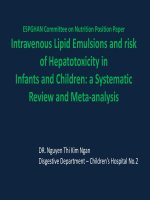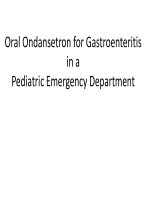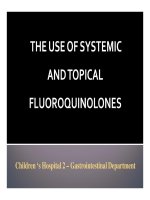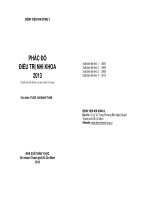Ralph mitchell, ji dong gu environmental Microbi(BookZZ org)
Bạn đang xem bản rút gọn của tài liệu. Xem và tải ngay bản đầy đủ của tài liệu tại đây (5.29 MB, 389 trang )
ENVIRONMENTAL
MICROBIOLOGY
SECOND EDITION
Edited by
Ralph Mitchell and Ji-Dong Gu
A JOHN WILEY & SONS, INC., PUBLICATION
ENVIRONMENTAL
MICROBIOLOGY
ENVIRONMENTAL
MICROBIOLOGY
SECOND EDITION
Edited by
Ralph Mitchell and Ji-Dong Gu
A JOHN WILEY & SONS, INC., PUBLICATION
Copyright © 2010 by Wiley-Blackwell. All rights reserved.
Published by John Wiley & Sons, Inc., Hoboken, New Jersey
Published simultaneously in Canada.
Wiley-Blackwell is an imprint of John Wiley & Sons, formed by the merger
of Wiley’s global Scientific, Technical, and Medical business with Blackwell Publishing.
No part of this publication may be reproduced, stored in a retrieval system, or transmitted in any form or
by any means, electronic, mechanical, photocopying, recording, scanning, or otherwise, except as
permitted under Section 107 or 108 of the 1976 United States Copyright Act, without either the prior
written permission of the Publisher, or authorization through payment of the appropriate per-copy fee to
the Copyright Clearance Center, Inc., 222 Rosewood Drive, Danvers, MA 01923, 978-750-8400, fax
978-750-4470, or on the web at www.copyright.com. Requests to the Publisher for permission should be
addressed to the Permissions Department, John Wiley & Sons, Inc., 111 River Street, Hoboken, NJ 07030,
201-748-6011, fax 201-748-6008, or online at />Limit of Liability/Disclaimer of Warranty: While the publisher and author have used their best efforts in
preparing this book, they make no representations or warranties with respect to the accuracy or
completeness of the contents of this book and specifically disclaim any implied warranties of
merchantability or fitness for a particular purpose. No warranty may be created or extended by sales
representatives or written sales materials. The advice and strategies contained herein may not be suitable
for your situation. You should consult with a professional where appropriate. Neither the publisher nor
author shall be liable for any loss of profit or any other commercial damages, including but not limited to
special, incidental, consequential, or other damages.
For general information on our other products and services or for technical support, please contact our
Customer Care Department within the United States at 877-762-2974, outside the United States at
317-572-3993 or fax 317-572-4002.
Wiley also publishes its books in a variety of electronic formats. Some content that appears in print may
not be available in electronic formats. For more information about Wiley products, visit our web site at
www.wiley.com.
Library of Congress Cataloging-in-Publication Data:
Environmental microbiology : second edition / edited by Ralph Mitchell, Ji-Dong Gu
p. cm.
Includes bibliographical references and index.
ISBN 978-0-470-17790-7 (cloth)
Printed in the United States of America.
10 9 8 7 6 5 4 3 2 1
CONTENTS
Contributors
vii
Preface
ix
1 Bacteria in the Greenhouse: Marine Microbes and Climate Change
1
Hugh W. Ducklow, Xos´e Anxelu G. Mor´an, and Alison E. Murray
2 Control of Waterborne Pathogens in Developing Countries
33
Tim Ford and Steve Hamner
3 New Molecular Methods for Detection of Waterborne Pathogens
57
Alison M. Cupples, Joan B. Rose, and Irene Xagoraraki
4 Microbial Transformations of Radionuclides in the Subsurface
95
Matthew J. Marshall, Alexander S. Beliaev, and James K. Fredrickson
5 Eutrophication of Estuarine and Coastal Ecosystems
115
Nancy N. Rabalais
6 Microbial Deterioration of Cultural Heritage Materials
137
Christopher J. McNamara, Nick Konkol, and Ralph Mitchell
7 Sorption and Transformation of Toxic Metals by Microorganisms
153
Xu Han and Ji-Dong Gu
8 Bioremediation of Hazardous Organics
177
Jennifer G. Becker and Eric A. Seagren
9 Biosensors as Environmental Monitors
213
Steven Ripp, Melanie L. DiClaudio, and Gary S. Sayler
10 Effects of Genetically Modified Plants on Soil Microorganisms
235
Nicole Weinert, Remo Meincke, Michael Schloter, Gabriele Berg, and
Kornelia Smalla
11 Anaerobic Digestion of Agricultural Residues
259
Vincent O’Flaherty, Gavin Collins, and Th´er´ese Mahony
v
vi
12
CONTENTS
Anaerobic Biodegradation of Solid Waste
281
Morton A. Barlaz, Bryan F. Staley, and Francis L. de los Reyes III
13
Low-Energy Wastewater Treatment: Strategies and Technologies
301
Thomas P. Curtis
14
Bioremediated Geomechanical Processes
319
Eric A. Seagren and Ahmet H. Aydilek
Index
349
CONTRIBUTORS
Ahmet H. Aydilek, Department of Civil and Environmental Engineering, University
of Maryland, College Park, Maryland
Morton A. Barlaz, Department of Civil, Construction, and Environmental Engineering,
North Carolina State University, Raleigh, North Carolina
Jennifer G. Becker, Department of Environmental Science and Technology, University
of Maryland, College Park, Maryland
Alexander S. Beliaev, Biological Sciences Division, Fundamental and Computational
Sciences Directorate, Pacific Northwest National Laboratory, Richland, Washington
Gabriele Berg, Environmental Biotechnology, Graz University of Technology, Graz,
Austria
Gavin Collins, Microbial Ecology Laboratory, Department of Microbiology and Environmental Change Institute, National University of Ireland, Galway, Ireland
Alison M. Cupples, Michigan State University, Department of Civil and Environmental Engineering, East Lansing, Michigan
Thomas P. Curtis, School of Engineering and Geosciences, Newcastle University,
Newcastle, United Kingdom
Francis L. de los Reyes III, Department of Civil, Construction, and Environmental
Engineering, North Carolina State University, Raleigh, North Carolina
Melanie L. DiClaudio, Center for Environmental Biotechnology, University of Tennessee, Knoxville, Tennessee
Hugh W. Ducklow, Marine Biological Laboratory, The Ecosystems Center, Woods
Hole, Massachusetts
Tim Ford, University of New England, Biddeford, Maine
James K. Fredrickson, Biological Sciences Division, Fundamental and Computational
Sciences Directorate, Pacific Northwest National Laboratory, Richland, Washington
Ji-Dong Gu, Division of Microbiology, School of Biological Sciences, The University
of Hong Kong, Hong Kong, China
Steve Hamner, Montana State University, Department of Microbiology, Bozeman,
Montana
Xu Han, Division of Microbiology, School of Biological Sciences, The University of
Hong Kong, Hong Kong, China
vii
viii
CONTRIBUTORS
Nick Konkol, Laboratory of Applied Microbiology, Harvard School of Engineering
and Applied Sciences, Cambridge, Massachusetts
Th`er´ese Mahony, Microbial Ecology Laboratory, Department of Microbiology and
Environmental Change Institute, National University of Ireland, Galway, Ireland
Matthew J. Marshall, Biological Sciences Division, Fundamental and Computational
Sciences Directorate, Pacific Northwest National Laboratory, Richland, Washington
Christopher J. McNamara, Laboratory of Applied Microbiology, Harvard School of
Engineering and Applied Sciences, Cambridge, Massachusetts
Remo Meincke, Environmental Biotechnology, Graz University of Technology, Graz,
Austria
Ralph Mitchell, Laboratory of Applied Microbiology, Harvard School of Engineering
and Applied Sciences, Cambridge, Massachusetts
Xos´e Anxelu G. Mor´an, Centro Oceanogr´afico de Xix´on, Instituto Espa˜nol de
Oceanograf´ıa, Xix´on, Spain
Alison E. Murray, Desert Research Institute, University of Nevada, Reno, Nevada
Vincent O’Flaherty, Microbial Ecology Laboratory, Department of Microbiology and
Environmental Change Institute, National University of Ireland, Galway, Ireland
Nancy N. Rabalais, Louisiana Universities Marine Consortium, Cocodrie, Louisiana
Steven Ripp, Center for Environmental Biotechnology, University of Tennessee,
Knoxville, Tennessee
Joan B. Rose, Michigan State University, Department of Fisheries and Wildlife, East
Lansing, Michigan
Gary S. Sayler, Center for Environmental Biotechnology, University of Tennessee,
Knoxville, Tennessee
Michael Schloter, Department for Terrestrial Ecogenetics, Helmholtz Zentrum
M¨unchen, Oberschleissheim, Germany
Eric A. Seagren, Department of Civil and Environmental Engineering, University of
Maryland, College Park, Maryland
Kornelia Smalla, Julius-K¨uhn Institute–Federal Research Centre for Cultivated Plants,
Institute for Epidemiology and Pathogen Diagnostics, Braunschweig, Germany
Bryan F. Staley, Department of Civil, Construction, and Environmental Engineering,
North Carolina State University, Raleigh, North Carolina
Nicole Weinert, Julius-K¨uhn Institute–Federal Research Centre for Cultivated Plants,
Institute for Epidemiology and Pathogen Diagnostics, Braunschweig, Germany
Irene Xagoraraki, Michigan State University, Department of Civil and Environmental
Engineering, East Lansing, Michigan
PREFACE
It is more than fifteen years since the publication of the last edition of Environmental
Microbiology. During that time there have been momentous advances in this field both
conceptually and experimentally. For example, we have become increasingly aware of
the involvement of microbial processes in climate change. New molecular techniques
now permit much more accurate identification of the microorganisms and processes
involved in both environmental deterioration and remediation.
In this volume we focus on the role of microorganisms in a wide range of ecosystems
and deterioration processes. We cover such diverse subjects as the role of microorganisms in the deterioration of cultural heritage materials and the effects of genetically
modified crops on microbial processes. In addition to providing historical reviews of
their subject, we have asked contributors to speculate on future trends. Our objective
in the volume is to further our understanding of the essential role played by microorganisms in both environmental deterioration and the control of pollution. We hope that
this book will be helpful to a wide range of scientists and engineers, and will stimulate
students to new and original approaches to environmental challenges.
R.M. would like to thank Trinity College, Dublin, Ireland and, particularly, Robin
Adams, the director of the college library. Much of the work for this book was carried
out in the Trinity College library. Both the help of the librarians and the excellent
electronic resources were an enormous help in the production of this book.
Ralph Mitchell
Harvard University
Ji-Dong Gu
University of Hong Kong
ix
CHAPTER 1
Bacteria in the Greenhouse:
Marine Microbes and Climate Change
HUGH W. DUCKLOW
Marine Biological Laboratory, The Ecosystems Center, Woods Hole, Massachusetts
´
XOSE´ ANXELU G. MORAN
´
´ Instituto Espanol
˜ de Oceanograf´ıa, Xixon,
´ Spain
Centro Oceanografico
de Xixon,
ALISON E. MURRAY
Desert Research Institute, University of Nevada, Reno, Nevada
1.1
INTRODUCTION: A MICROBIAL OCEAN IN A WARMING WORLD
The global ocean covers 70% of Earth’s surface and comprises most of the volume
of the biosphere (except the deep subsurface). It supports about half the annual net
primary production (NPP) on the planet (Figure 1.1) (Field et al., 1998). This vast,
interconnected network of marine ecosystems is warming in response to anthropogenic
climate change, with uncertain consequences for human societies. In this chapter we
address the possible responses of ocean warming on marine microbes (protists, phytoplankton, bacteria, and archaea, with emphasis on the bacteria). Other anthropogenic
changes related to CO2 accumulation in the atmosphere, such as ocean acidification
(Orr et al., 2005), will also have uncertain effects on ocean microbes.
The ocean is, and always has been, dominated by microbes. Microscopic unicellular
phytoplankton and cyanobacteria inhabiting the sunlit upper approximate 100 m of the
water column carry out nearly all the photosynthesis on which oceanic life depends
(Falkowski et al., 1998, 2000). NPP on land and in the oceans is the process dominating solar energy and CO2 fixation into organic matter, thus driving the global carbon
cycle (Houghton, 2007). Nearly all of the approximately 50 Pg (1 petagram = 1 Pg =
1015 g = 109 tons) of carbon fixed annually in marine photosynthesis is ultimately oxidized by bacterioplankton, protozoans, and zooplankton (Ducklow and Carlson, 1992)
with a very small fraction (<0.1%) escaping heterotrophic metabolism in the deep water
column to be buried in the sedimentary record and hydrocarbons. The myriad pathways
by which marine organic matter is cycled through particulate and dissolved forms and
Environmental Microbiology, Second Edition Edited by Ralph Mitchell and Ji-Dong Gu
Copyright © 2010 Wiley-Blackwell.
1
2
BACTERIA IN THE GREENHOUSE: MARINE MICROBES AND CLIMATE CHANGE
ATMOSPHERE 780 + 3/yr
decomposition
58
R 59
55
GPP 120
2
rivers
VEGETATION 550 + 1
6
0.5
92
90.5
SURFACE OCEAN
1.6
dissolved organic 25
dissolved CO2 700 + 0.3
NPP 48
0.4
3
LITTER & SOIL 1500
42
BIOTA 3
land-use
change
LAND
R 37
11
DEEP OCEAN
dissolved organic 1000
dissolved CO2 36,000 + 1.4
0.05
SEDIMENT
OCEAN
FOSSIL HYDROCARBONS
5000–10,000
Figure 1.1 The global carbon cycle, including human perturbations in the 1990s. The quantities in the boxes are the size of the carbon reservoir in petagrams (Pg; 1015 g), with the
annual growth, if any, due to the perturbations. Note that there is direct exchange between the
atmosphere and terrestrial ecosystems, whereas exchange with the ocean is mediated by the
physicochemical exchange across the air–sea interface. The downward transport of organic carbon, both particulate and dissolved, constitutes the biological pump. There is a riverine input of
about 0.5 Pg from the land to ocean, balanced by outgassing and burial in sediments. Currently,
the annual net land sink for atmospheric CO2 is 1 Pg and the ocean sink is 2 Pg, leaving an
annual net anthropogenic accumulation in the atmosphere of 3.2 Pg. (Modified from Houghton,
2007.) (See insert for color representation.)
back into CO2 overwhelmingly involve microbial exchanges among organisms less than
1 to 5 μm in diameter—the microbial loop (Pomeroy, 1974; Azam et al., 1983; Azam
and Worden, 2004; Azam and Malfatti, 2007). This large-scale view of global biogeochemistry makes the point that microbial ecology depends ultimately on the patterns
and products of photosynthesis. In metabolizing the products of photosynthesis on land
and in the sea, bacteria perform important ecosystem services, such as decomposition,
nutrient cycling, regulating the composition of the atmosphere, enhancing soil fertility,
and purifying water, on which human societies depend for healthy and sustainable
existence (Ducklow, 2008). Here we review marine plankton and microbial ecology
to understand how marine bacteria may respond to anthropogenic climate change, and
suggest potential research directions for making more informed projections.
Bacteria respond directly to changes in environmental temperature, but these
responses occur in complex communities with phytoplankton and zooplankton and in
INTRODUCTION: A MICROBIAL OCEAN IN A WARMING WORLD
3
a complex biogeochemical milieu. After reviewing the microbial loop to set the stage
for a more detailed look at the connections between climate and plankton processes,
we take two complementary approaches. First, we examine how bacterial activity
varies as a function of temperature. Then we examine how marine phytoplankton
respond to climate variability in the ocean and how these responses modulate the
effects of climate change on bacterial and animal consumers. We have a reasonable
understanding of the mechanisms by which phytoplankton (especially eukaryotes) will
respond to climate change, based on physical theory and knowledge of past changes
from the fossil record. But as Falkowski and Oliver (2007) stated in their review of
phytoplankton and climate, “Whether this fundamental principle holds for marine
prokaryotes remains to be seen, because the spatial and temporal distribution of
prokaryotic taxa, as well as their relevant ecophysiological attributes, is not yet well
characterized.” Our knowledge of the mechanisms linking phytoplankton to bacterial
variability is still fragmentary, but much new research is directed at this problem. We
use this nascent understanding to suggest how bacterial carbon cycling may change
and what knowledge is needed for better predictions of such changes. Finally, we
synthesize these approaches and consider scenarios of how microbial communities
will respond (or may already be responding) to climate change in the coastal seas,
cold polar seas, and in warm oligotrophic subtropical gyres. First, we sketch briefly
the projected physical changes to the global oceans in response to anthropogenic
climate forcing.
1.1.1
Impact of Climate Change on the Oceans
The world is warming in response to climate change driven by the accumulation of
anthropogenic greenhouse gases (Kerr, 2007). The 2007 IPCC Assessment projects
that the mean global surface atmospheric temperature will rise by 1 to 6◦ C by 2099,
depending on various assumptions or scenarios of population growth, economic and
technological development, energy use, and greenhouse gas emissions (IPCC, 2007b).
The projected warming is not uniform in space or time, with different rates forecast for various regions and seasons. Surface ocean temperatures may rise by 3 to
7◦ C in some regions, with the largest increases (although not necessarily the largest
effects; see below) in polar seas (Figure 1.2). Climate warming will take longer to
percolate into the deep ocean. The surface ocean west of the Antarctic Peninsula has
already increased by 1◦ C since the 1950s (Meredith and King, 2005), and Arctic sea
ice has declined alarmingly in the past few years (Serreze et al., 2007). Enhanced
greenhouse warming is projected to cause impacts ranging from changes in winds,
clouds, sea level, precipitation, storm frequency and intensity to more complex alterations in long-term climate modes (e.g., ENSO), ecosystems, biodiversity, and human
well-being (Millennium Ecosystem Assessment, 2005; IPCC, 2007a). The impact of
changes in surface temperatures, clouds, and wind on ocean stratification, mixing, and
circulation has been examined using coupled atmosphere–ocean general circulation
models (AOGCM) (Meehl et al., 2007). In addition to atmospheric warming, major
changes predicted by many different AOGCMs include increases in ocean surface
stratification in the tropics and subtropics; and reductions in mixed-layer depth in the
middle to upper latitudes (Figure 1.3; Boyd and Doney, 2002), Other changes include
loss of sea ice in both hemispheres (especially in the north), and increases in westerly
winds and coastal upwelling (Sarmiento et al., 2004). As the temperature fields shown
4
BACTERIA IN THE GREENHOUSE: MARINE MICROBES AND CLIMATE CHANGE
Figure 1.2 Multimodel mean of annual mean surface warming (surface air temperature
change,◦ C) for scenarios B1, A1B, and A2, and three time periods, 2011 to 2030 (left), 2046 to
2065 (middle), and 2080 to 2099 (right). Stippling is omitted for clarity (see the text). Anomalies
are relative to the average of the period 1980–1999. (From IPCC, 2007b, with permission of
the IPCC, (See insert for color representation.)
in Figures 1.2 and 1.3 indicate, projected changes are far from uniform. Specification of the changes in any particular region is more uncertain than projections of the
global means. Responses of ocean ecosystems and biogeochemistry are less certain
than physical changes.
1.1.2
The Microbial Loop and Marine Bacterioplankton Communities
A typical milliliter of seawater harbors about 106 bacterial and archaeal cells, the great
majority of which are revealed to be active based on fluorescent in situ hybridization
and visualization of intact ribosomes (Church et al., 2003). This assemblage contains
extraordinary genetic and metabolic diversity (Venter, 2004; Sogin et al., 2006), and
with it the potential for adaptation to wide ranges and combinations of environmental conditions. The planktonic archaea make up a variable fraction of the prokaryote
assemblage, comprising up to about 50% of the total abundance in deep-ocean waters,
but less in the more active surface layer (Karner et al., 2001). Recent work has revealed
new insights concerning the metabolism and ecological roles of planktonic GI marine
crenarchaeota and GII marine euryarchaeota. Collective evidence suggests that perhaps
a significant portion of the GI marine crenarchaeota are ammonia oxidizers (Francis
et al., 2005; Konneke et al., 2005; Hallam et al., 2006; Wuchter et al., 2006), while
the first environmental genomic sequence from a GII marine euryarchaeote identified
a proteorhodopsin-encoding gene (Frigaard et al., 2006). Both of these metabolisms
are consistent with the ecological distributions of these organisms in the ocean, where
the GI marine crenarchaeota are typically found below the photic zone, and the GII
5
INTRODUCTION: A MICROBIAL OCEAN IN A WARMING WORLD
°C
A. SST (Future-Control)
90°N
10.0
7.5
5.0
4.0
3.0
2.0
1.5
1.0
0.5
0.0
−0.5
45°N
0°
45°S
90°S
0°
90°
180°
270°
−1.0
360°
meters
shallower
B. Mixed Layer Depth (Future-Control)
1000
500
300
100
50
30
10
5
3
0
−3
−5
−10
−30
−50
−100
−300
−500
−1000
90°N
45°N
0°
45°S
90°S
0°
90°N
90°
180°
270°
360°
deeper
(kg m−4)
more strat.
0.0300
C. dρ/d at 50m (Future-Control)
0.0100
0.0030
45°N
0.0010
0.0003
0.0000
0°
−0.0003
−0.0010
45°S
−0.0030
−0.0100
90°S
0°
90°
180°
270°
360°
−0.0300
less strat.
Figure 1.3 Projected climate-mediated changes in ocean physical forcing (future-control, i.e.,
2060–2070 minus the present) from the NCAR Community Climate System Model for (A) sea
surface temperature, (B) mixed-layer depth, and (C) upper ocean (50 m) stratification. (From
Boyd and Doney, 2002, with permission of the American Geophysical Union.) (See insert for
color representation.)
6
BACTERIA IN THE GREENHOUSE: MARINE MICROBES AND CLIMATE CHANGE
marine euryarchaeota are found in oceanic surface waters. Marine aerobic heterotrophic
bacteria directly take up and metabolize low-molecular-weight (LMW, <500 MW) dissolved organic matter (DOM) such as easily metabolized mono- and oligosaccharides,
free amino acids, and small peptides (Kirchman et al., 2001). Most bacterial cells in
the ocean are free-living and thus dependent on DOM (Azam and Hodson, 1977). Free
and attached bacteria hydrolyze polymeric substances and particulate matter into LMW
compounds that can be passed through cell membranes (Hoppe et al., 1993). Bacterial
metabolism in the surface ocean depends predominantly on uptake of labile LMW and
HMW compounds with turnover times of minutes to days (Fuhrman, 1990). However
bacterial metabolism may be supplemented by a variable contribution from semilabile DOM that turns over on approximately seasonal time scales (Kirchman et al.,
1993; Carlson and Ducklow, 1996). Bacterial turnover of DOM and the associated
remineralization of micro- and macronutrients such as iron, nitrogen, and phosphorus
close the major biogeochemical cycles of these elements in the sea (Falkowski et al.,
2008).
Marine net primary production is processed through a complex trophic network of
consumers, with a global average 15 to 20% escaping microbial respiration in the
euphotic surface layer (upper approximately 100 to 200 m) to be exported to the
ocean interior. A change in this fraction would have a major impact on the global
carbon cycle (Sarmiento and Toggweiler, 1984). In the open sea and in many coastal
and shelf seas under stratified conditions, carbon and nitrogen flows are dominated
by microbial food webs (Figure 1.4). The intensive recycling of the dissolved and
particulate fractions of the NPP through consumers results in a large fraction (about
50%) of the NPP passing through bacteria and the dissolved pool (Pomeroy, 1974;
Williams, 1981). In the open sea, most grazing is by microzooplankton (Landry and
Kirchman, 2002; Calbet and Landry, 2004); thus most heterotrophic consumption and
respiration is microbial. Microbial dominance of marine food webs appears to hold
even for the Antarctic seas, previously thought to be the last bastion of the classical
diatom–krill–whale food chain based on large plankton (Daniels et al., 2006).
As this discussion and Figure 1.4 suggest, a large fraction of the organic matter
fixed in marine NPP is cycled through dissolved pools and metabolized by bacteria. All
organisms leak DOM into the environment via passive diffusion, cell lysis and breakage, and active metabolic processes (Bjørnsen, 1988; Nagata, 2000). Phytoplankton
actively exude dissolved organic carbon (DOC) to dispose of excess photosynthetically fixed carbon not combined with nitrogen and phosphorus into biomass in the
approximate Redfield ratio 106 : 16 : 1 (C/N/P). Phytoplankton exudation is the process most directly coupling primary to bacterial production (Mor´an et al., 2002), but
not the only process. Larger-celled phytoplankton such as diatoms may be broken
between capture and ingestion by crustacean predators, spilling their fluid contents,
in a process known as sloppy feeding (Lampert, 1978). According to Nagata (2000),
egestion and excretion during feeding by protistan grazers may be the greatest relative contribution to photosynthetically derived DOC fluxes. Clearly, passive diffusion
across phytoplankton cell membranes, active exudation, egestion, and sloppy feeding
will produce DOM with different chemical composition and at different rates. Following ingestion and digestion, zooplankton grazers excrete DOM, and it also diffuses
out of fresh fecal material (Jumars et al., 1989). Additional DOM may be released
during viral lysis, abiotic dissolution, or bacterial hydrolysis of suspended and sinking
detrital particles and marine snow. Figure 1.4 suggests one scenario for the relative
INTRODUCTION: A MICROBIAL OCEAN IN A WARMING WORLD
7
Figure 1.4 Microbial food-web diagram, showing exchanges of carbon in the oceanic surface
layer. The flows are normalized to NPP = 1.0. The partitioning of flows among compartments
is based on the physiological budget model given in Anderson and Ducklow (2001). Note
that the carbon flows are dominated by zooplankton grazing (70% of NPP), DOC uptake by
bacteria (50%), and heterotrophic respiration (80%). In this depiction the respiration is divided
evenly among zooplankton and bacteria, but note that oceanic zooplankton may be dominated by
protozoans smaller then 20 μm. Here the bacterial production is 12% of the particulate NPP, the
fraction approximated by traditional 14 C assays, and a typical value for the open sea (Ducklow,
1999). Solid lines, biomass flows and respiration; dotted lines, dissolved flows; dashed–dotted
lines, detrital flows and mortality. (See insert for color representation.)
magnitudes of DOC fluxes from these diverse sources. This model explains how the
level of bacterial production (BP) is limited by how much DOC flows through the
food web to bacteria, and by the bacterial allocation of the carbon ingested between
production and respiration (bacterial growth efficiency; see below). Phytoplankton
extracellular release (PER) may vary widely even in healthy cells, ranging from less
than 5 to more than 50% of the total (dissolved plus particulate) primary production
(Mor´an and Estrada, 2002). Anderson and Ducklow (2001) outlined the importance
of PER vs. grazer-related sources in setting the overall level of bacterial metabolism
in the sea. Williams (1981) hypothesized a larger role for PER, whereas Jumars et al.
(1989) emphasized the primacy of grazers as DOM sources. Depending on the season,
location, and particular environmental conditions of nutrient and light levels, grazing intensity, and other factors, many different scenarios are possible. Specifying how
bacteria may respond to climate change requires better understanding of these rates,
and the chemical composition of DOM released from a multitude of sources. For
example, DOM released by grazing activities is probably of lower quality for bacterial nutrition, due to enzymatic attack, than that released by phytoplankton or viral
8
BACTERIA IN THE GREENHOUSE: MARINE MICROBES AND CLIMATE CHANGE
lysis (Nagata, 2000). Changes in the physical or ecological state of ocean ecosystems affecting herbivores may cascade to changes in bacterial activity or community
composition.
Our understanding of microbial life in the oceans has escalated rapidly following
the application of molecular tools (e.g., gene or whole genome sequencing, molecular profiling, fluorescent in situ hybridization), many of which have targeted the SSU
rRNA gene, a phylogenetically informative molecule in which all forms of life can
be compared. Marine microbial communities are diverse, although moreso at finer
taxonomic scales than at gross phylum levels. Overall at the phylum level, there are
some differences between ocean realms and between coastal vs. open ocean. Some distribution and biogeographically-based patterns are now emerging following extensive
surveys of the world’s ocean with these new tools. The upper oceans are dominated
(25 to 33%) by SAR11-related bacteria members of the α-proteobacteria (Morris et al.,
2002), and the deeper oceans below 150 m harbor abundant marine GI crenarchaeotal populations (20 to 40% of DAPI-stained cells; Karner et al., 2001; Teira et al.,
2006). Another numerous group of α-proteobacteria, common to both coastal and
open ocean regions, the Roseobacter clade is often abundant (about 15% of the community; Buchan et al., 2005). There is high phylogenetic and functional diversity of
marine γ -proteobacteria, which comprise a significant fraction of the bacterioplankton.
Interestingly, though, γ -proteobacteria are often the most commonly cultivated marine
bacteria, yet the cultivated species are rarely detected in molecular surveys. The more
commonly detected γ -proteobacteria in cultivation-independent surveys on global scale
harbor diverse metabolisms, and are in a number of cases strictly oligotrophic (Cho
and Giovannoni, 2004). Marine Bacteriodetes-related organisms are a third group that
includes diverse members that are not well represented in culture collections but can
be numerically dominant (Cottrell et al., 2000). Interestingly, we now also know that
species in each of these major phylogenetic groups found in oceanic photic zones
contain proteorhodopsin, a membrane-associated light-driven proton pump. How these
organisms utilize proteorhodpsin to supplement growth is still not well understood,
although it may be a theme for organisms living in the upper ocean. Campbell et al.
(2008) estimated that at least 14% of organisms living in the photic zone contain
proteorhodopsin homologs.
Biogeographic, temporal, and spatial surveys have also revealed considerable diversity and dynamics in community composition. For example, Pommier et al. (2007)
compared the diversity of bacterioplankton assemblage at nine different sites around
the world. Their findings suggest that despite the fact that the major phyla detected
were similar, there were very few sequences that were detected repeatedly. Seasonal
variation in coastal Antarctic waters is dramatic, with bacterial richness shifting significantly (Murray et al., 1998; Murray and Grzymski, 2007) and archaeal populations
increasing in relative proportions in winter (Massana et al., 1998; Murray et al., 1998;
Church et al., 2003). Vertical density stratification in the ocean (see below) has the
most apparent impact on gradients of diversity in the ocean, however, as community
diversity shifts most significantly with depth rather than with longitude or latitude.
One of the caveats of nearly all studies is that the diversity is undersampled but new
technologies in massively parallel DNA sequencing promise to reshape our views of
species richness and our ability to compare in detail community composition from
many sites using the same deep sequencing approach (Sogin et al., 2006; Huber et al.,
2007).
BACTERIAL ACTIVITY AND TEMPERATURE
1.2
9
BACTERIAL ACTIVITY AND TEMPERATURE
Temperature is a critical property affecting virtually all metabolic processes of organisms (Gillooly et al., 2001; Brown et al., 2004), especially those of microbes (Price
and Sowers, 2004). However, by concentrating solely on temperature as a key control
of bacterial properties, we are necessarily neglecting other biological interactions that
shape bacterial communities in the oceans (Strom, 2008). Theoretically, with no other
constraints and unlimited resources, increases in temperature should result through
increased enzymatic activity in higher growth rates and eventually, larger abundances
of cells. Thus, a first and indirect approach to the possible effects of climate warming
on heterotrophic bacteria could be the examination of how their abundance or activity
changes with temperature in present-day natural conditions (Figure 1.5). A corollary to
this reasoning is that if resources (nutrients and organic matter) are limiting, increased
temperature will not necessarily cause increased activity.
The major problem with trying to describe the response of bacteria to temperature is
to separate it from other environmental factors that actually covary with temperature,
such as nutrient concentration or primary productivity, which may themselves have a
larger effect on bacterial properties (Lomas et al., 2002). In permanently warm regions
or during summer in temperate waters, strong stratification of the upper layers of
the water column precludes the input of inorganic nutrients from below the euphotic
zone, thus severely limiting the photosynthetic fixation of CO2 (Longhurst, 1998). A
simple way around this complication is to correct by the other limiting factor, such
as examining the relationship of the ratio of bacteria to phytoplankton biomass or
activity versus temperature (Li et al., 2004; Apple et al., 2008). In Li’s analysis, the
bacteria/phytoplankton biomass ratio increases with increasing temperature up to an
estimated upper limit of 1, consistent with the predictions of the food-web model of
Laws et al. (2000).
Despite the complex nature of interactions between temperature, substrate availability, cell size and abundance in the ocean, strong apparent increases with temperature in
the abundance of picoplankton, the smallest size class of planktonic organisms (< 2 μm
in diameter) comprising all free-living heterotrophic bacteria, have consistently been
reported for different aquatic ecosystems (Li, 1998; Rae and Vincent, 1998; Agawin
et al., 2000; Li et al., 2006; Mor´an et al., 2008). Heterotrophic bacterial numbers
generally peak in the summer months, while minima are frequently found during winter in most regions (Li, 1998; Steinberg et al., 2001; Calvo-D´ıaz and Mor´an, 2006;
Alonso-S´aez et al., 2008; Garneau et al., 2008). This relationship is, however, not constant through the entire −2 to 30◦ C temperature range. Usually, the initial increase in
abundance with temperature in colder conditions is followed by more constant or even
decreasing abundance (Hoch and Kirchman, 1993; Shiah and Ducklow, 1995), and
with considerably more variation, as temperature rises above some value around 15◦ C
(Figure 1.5A). Bacterial growth rates calculated as production/biomass ratios also show
a remarkably similar response to temperature, with no further significant increases at
temperatures above 15◦ C (Figure 1.5B). This figure implies that climate warming may
alter the microbial ecology of both polar and tropical environments, representatives of
extreme temperature conditions of Earth’s marine ecosystems, in different ways. We
use these environments as case examples of possible changes in carbon fluxes mediated
by bacteria in a warmer ocean (see below).
10
BACTERIA IN THE GREENHOUSE: MARINE MICROBES AND CLIMATE CHANGE
Bacterial abundance (cells mL−1)
A
10000000
1000000
100000
0
10
20
30
20
30
Temperature (°C)
Bacterial specific growth rate (d−1)
B
0.1
0.01
0
10
Temperature (°C)
Figure 1.5 (A) Relationship between bacterial abundance and temperature. Closed circles are
mean annual values at the surface of different regions of the world ocean. Open circles are
mean ± SE annual values in 2006 at the surface of three stations in the southern Bay of Biscay.
Open triangles are mean ± SE values averaged for the euphotic layer from studies that partially
covered the annual cycle in the Antarctic, Arctic, subarctic Pacific, North Atlantic, Arabian, and
equatorial Pacific. (B) Bacterial specific growth rates (BP/BB per day) vs. temperature of the
two data sets added to Li’s original figure. The shaded area represents the general change in
response at temperatures at or above 15◦ C. (Modified from Li, 1998.)
BACTERIAL ACTIVITY AND TEMPERATURE
11
Since bacterial abundance is the result of in situ growth minus losses due to predation and lysis, not necessarily involving the same temperature dependences (Sherr
et al., 1988), we now focus on the intrinsic physiological processes of bacteria that are
affected directly by temperature. The two fluxes mediated by bacteria that are most relevant from the perspective of biogeochemical cycling of organic matter are bacterial production (BP) and respiration (BR). BP and BR are related by bacterial growth efficiency
(BGE), which is the fraction of the total organic carbon assimilated or bacterial carbon
demand (BCD) that is used to build up biomass: BGE = BP/BCD = BP/(BP + BR).
A more mechanistic approach involves the use of mathematical descriptions of the
temperature dependence of BP and BR. The simplest is the temperature coefficient,
Q10 , the factor by which a biological reaction changes with a temperature increase
of 10◦ C. Although as for other planktonic groups, the mean Q10 for BP, BR, and
growth rates clusters around 2 (Robinson and Williams, 1993; Kirchman et al., 1995;
Lomas et al., 2002; Kirchman et al., 2005), actual values may vary considerably as
much within as across regions (Pedros-Ali´o et al., 2002; Middelboe and Lundsgaard,
2003). This pattern argues against the use of a fixed Q10 value in models predicting
biogeochemical responses to rising sea temperatures.
A more rigorous description of the temperature dependence of metabolic rates stems
from the work of van’t Hoff and Arrhenius in the late nineteenth century on chemical
reactions, later applied to biological processes. The van’t Hoff –Arrhenius equation
(Arrhenius, 1915) (Q = Q0 e−Ea/kT ), also called Boltzmann’s factor (Gillooly et al.,
2001; Brown et al., 2004; Allen et al., 2005), describing the exponential increase
in metabolic rates with temperature was recently extended into the more general
framework of the metabolic theory of ecology (MTE) (Brown et al., 2004). The
MTE predicts a value of activation energy Ea of 0.65 eV for heterotrophic organisms
(Brown et al., 2004; Allen et al., 2005). In a recent review of published data on
temperature and bacterial metabolism, L´opez-Urrutia and Mor´an (2007) showed that
the temperature dependencies of cell-specific BP and BR rates were statistically
indistinguishable, with Ea values close to the predicted 0.65 eV (0.42 to 0.59
eV) (Figure 1.6). In other words, although the absolute amount of organic carbon
processed by bacteria may change in the future, they would essentially be allocating
the same fraction of resources to growth (BP) and metabolism (BR) in a warmer
scenario, contradicting previous claims of a strong inverse relationship of BGE with
temperature (Rivkin and Legendre, 2001). Invariant BGE values with an increase
of 2◦ C over in situ temperatures have been shown recently in an annual cycle in
Mediterranean coastal waters (V´azquez-Dominguez et al., 2007). The relationship
between BGE and temperature observed by Rivkin and Legendre (2001) probably
reflects variations in regional ecology rather than a direct temperature effect.
However, resource limitation strongly affected the temperature-corrected BP,
while BR remained unaltered (L´opez-Urrutia and Mor´an, 2007). Hence under
resource-limiting conditions, assimilated organic carbon (BCD) would decrease solely
at the expense of BP. Although the response of BP to temperature was constant
at three levels of resource availability using chlorophyll as a proxy for bacterial
substrates (<0.5, 0.5 to 2, >2 mg of chlorophyll per cubic meter), the intercepts were
significantly different (1.6). The implication of this result is that low-productivity areas
(<0.5 mg chlorophyll per cubic meter) will have lower BP than that of eutrophic
regions (>2 mg m−3 ) but essentially the same BR. As a consequence, BGE would
decrease with decreasing chlorophyll concentrations, from about 30% at values greater
12
BACTERIA IN THE GREENHOUSE: MARINE MICROBES AND CLIMATE CHANGE
42
43
Temperature (1/kT, eV−1)
41
40
39
38
Metabolism (log10 fgC cell−1d−1)
2
= BGE
1
BR
1
BP
↓ BGE
2
0
−1
−2
−3
Chlorophyll concentration < 0.5 mg m
−3
0.5 > Chlorophyll concentration < 2 mg m
−3
Chlorophyll concentration > 2 mg m
−3
0
10
20
Temperature (°C)
30
Figure 1.6 Individual rates of bacterial production (BPi ) and respiration (BRi ) versus temperature at three levels of chlorophyll concentration. The black line represents the relationship between ln BRi and 1/kT (y = 26.49 − 0.59x) and the colored lines represent the ln
BPi –temperature relationships for each data subset (green, y = 18.14 − 0.42x; red, 20.54 −
0.50x; blue, 22.58 − 0.58x). An increase in temperature with no changes in resource availability would result in similar increases in BPi and BRi (i.e., the same BGE: case 1). Resource
limitation would slow the rate of increase of BPi with temperature compared to BRi , thus
lowering BGE (case 2). (Modified from L´opez-Urrutia and Mor´an, 2007.) (See insert for color
representation.)
than 5 μg/L to values about 5% at lower chlorophyll levels, confirming previous work
on systematic changes of the BGE with resource availability (del Giorgio and Cole,
1998). We suggest that a climate-induced change toward lower phytoplankton biomass
and production in vast areas of the oligotrophic ocean (Bopp et al., 2001; Behrenfeld
et al., 2006) or a shift in composition to smaller organisms (Karl, 1999a) (see below)
would affect BGE by changing the resource level at which the BP–temperature
relationship operates. That is, if we collected data in a warmer ocean in 2100 at
exactly the same locations as those used for plotting Figure 1.6, substantially more
of the data would fall in the oligotrophic and mesotrophic categories, so the BGE
would decrease—but due to resource limitation rather than to a direct temperature
effect. To sum up, increases in temperature will undoubtedly increase BR and BP, but
respiration would proceed unabated while production will probably level off. This is
because BP is affected by resource availability, which is influenced by temperature.
The obvious consequence is that proportionally more dissolved organic carbon would
be released as CO2 by bacteria than is made available as biomass to bacteriovores in
marine food webs. This shift would have follow-on effects for nutrient limitation and
upper trophic levels (Ducklow et al., 1986).









